Abstract
The protein product of T4 gene 63 catalyzes both the attachment of tail fibers to fiberless phage particles and the ligation of single-stranded RNA (Snopek at al., Proc. Natl. Acad. Sci. U.S.A. 74:3355-3359, 1977). To investigate whether the gene 63 product has a role in nucleotide metabolism, we isolated false revertants of amM69 in gene 63. We screened for revertants that could grow at 30 degrees C but not at 43 degrees C on Escherichia coli OK305 when nucleotides were limiting. These false revertants contained the original mutation in gene 63 and new suppressor mutations. Some of these suppressor mutations caused temperature sensitivity by themselves, allowing single mutants carrying the suppressor to be recognized and isolated. The results of mapping and complementation studies indicated that most of these ts suppressors were in the t gene (lysis), one was in gene 5 (baseplate), and one was in gene 18 (sheath). The mutation in gene 18, tsDH638, suppressed three different amber mutations in gene 63 but did not suppress amber mutations in several other genes. None of the suppressors that were characterized were in genes with known functions in nucleotide metabolism. However, an intriguing property of these false revertants was that they were very sensitive to hydroxyurea, an inhibitor of nucleotide metabolism.
Full text
PDF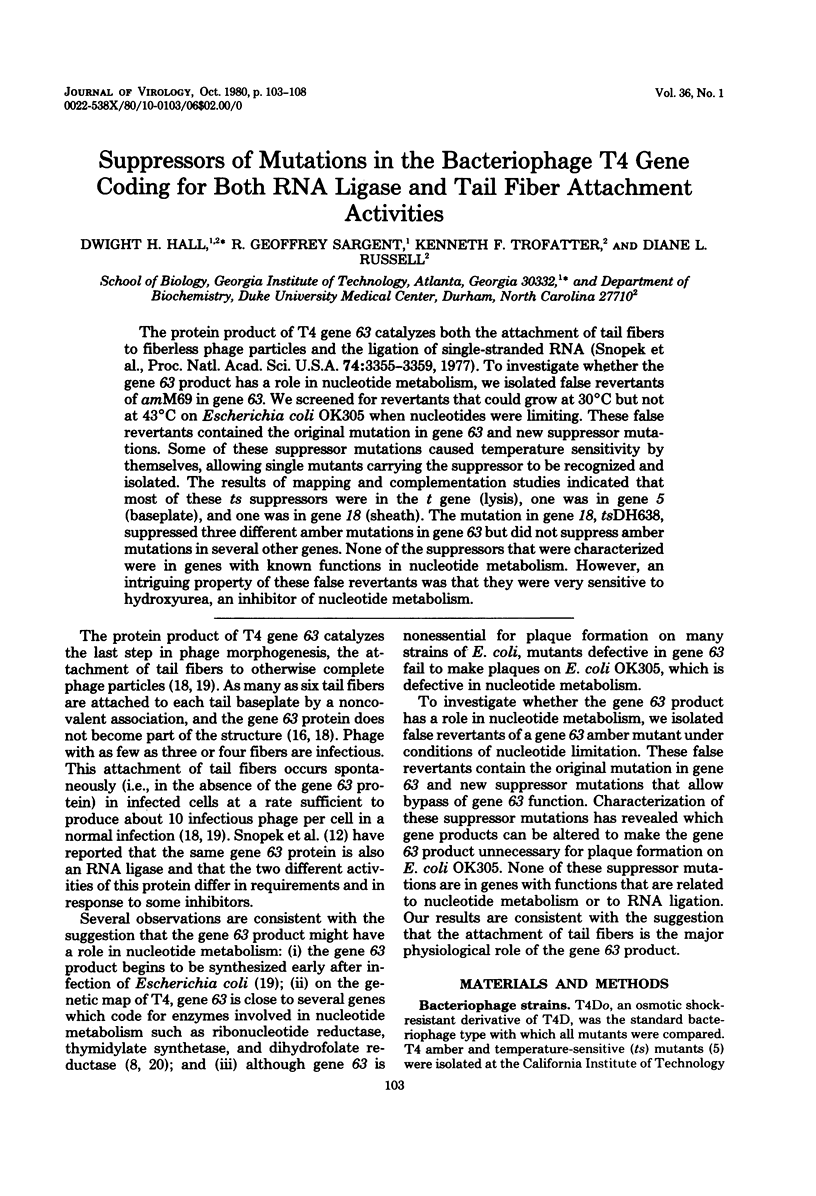
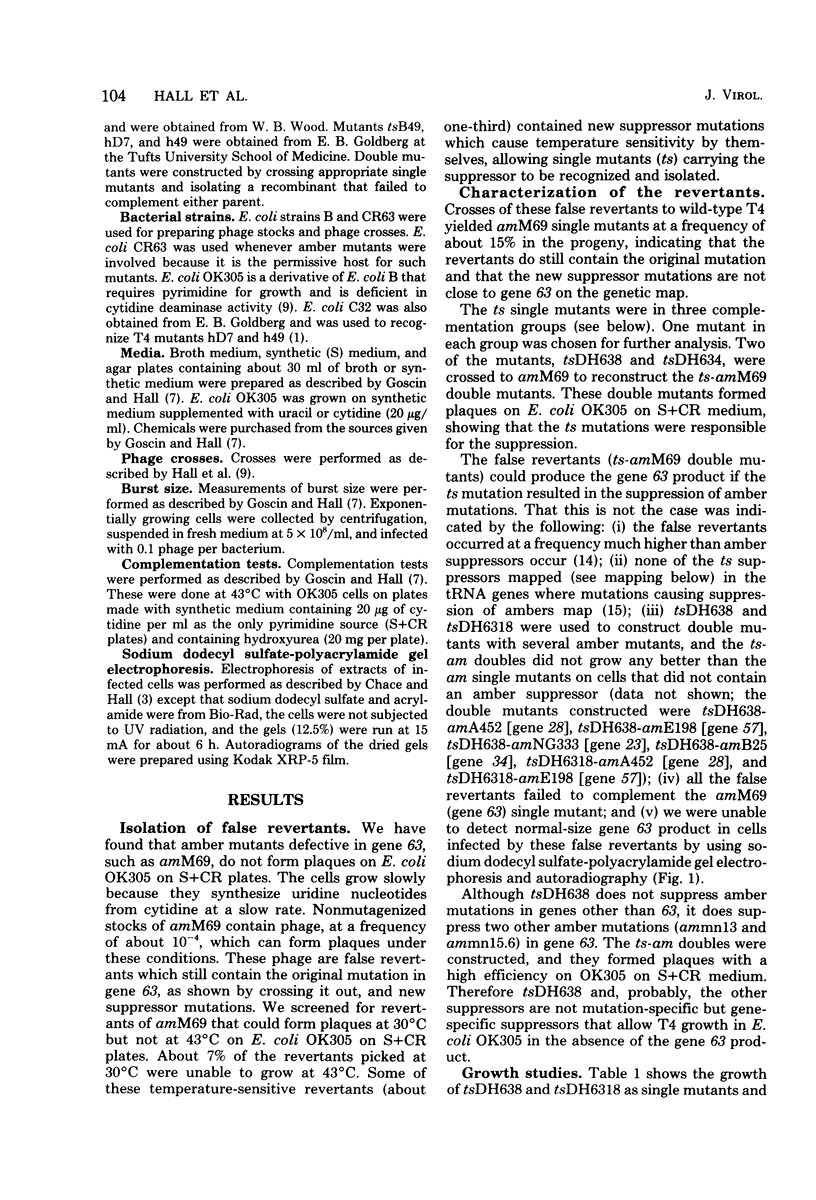
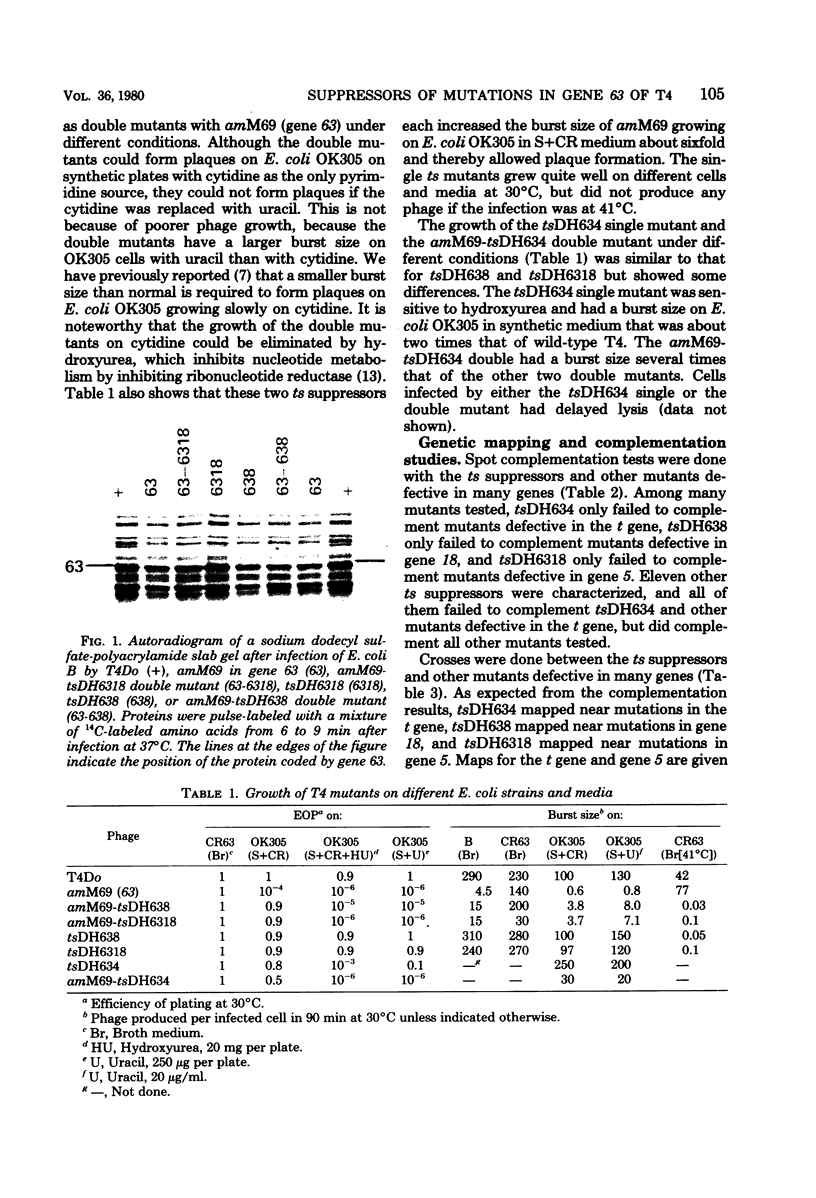
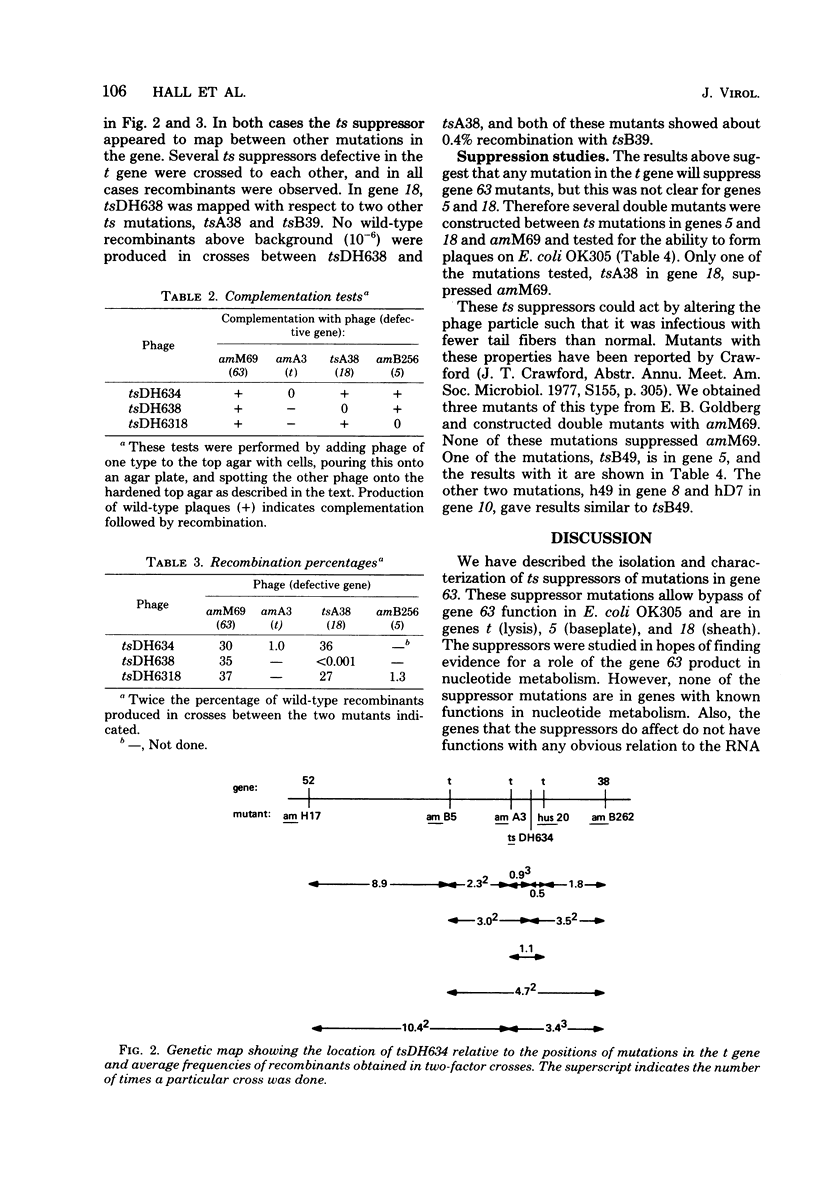
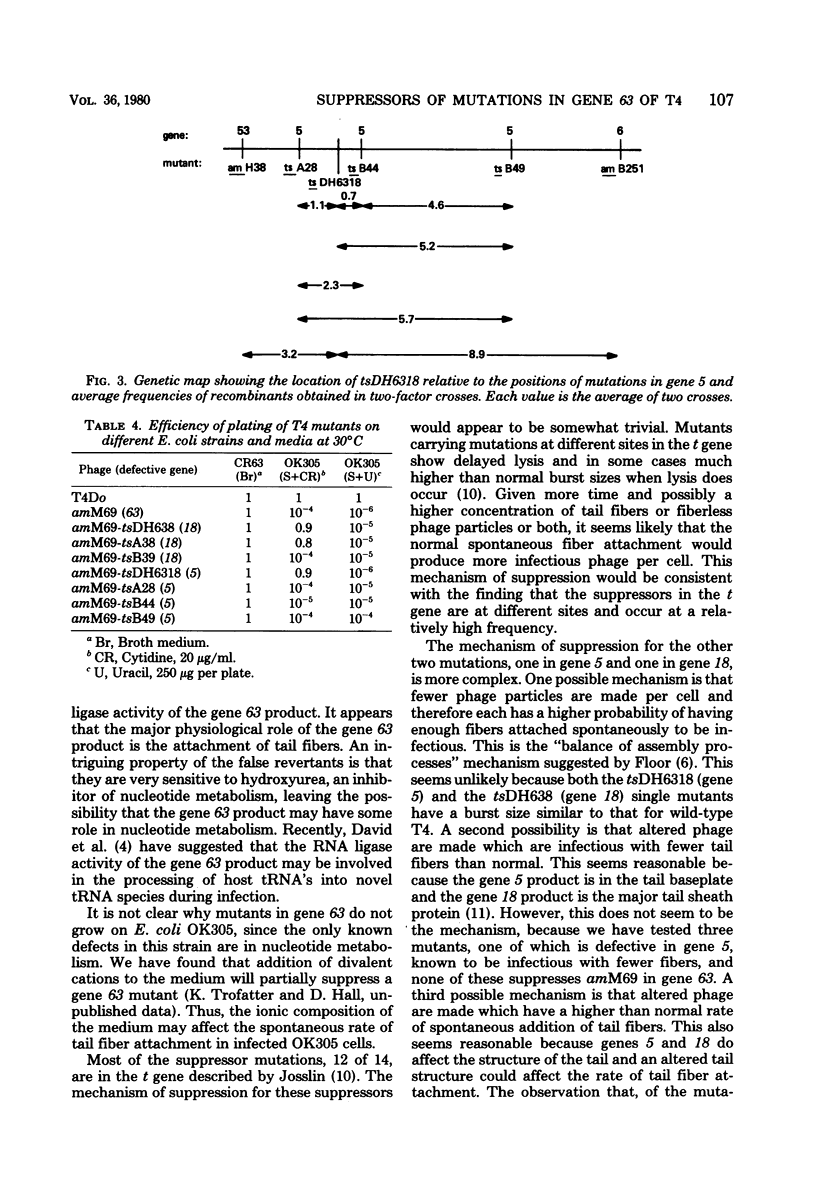
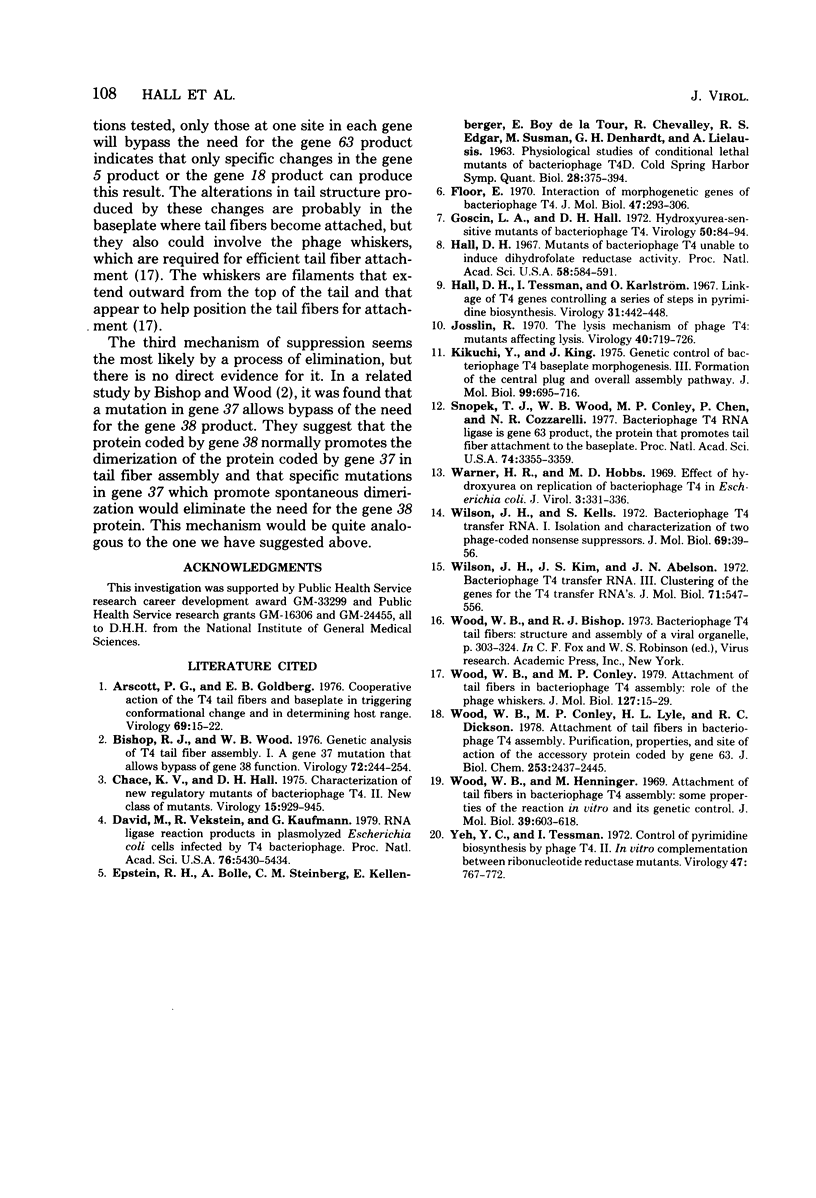
Images in this article
Selected References
These references are in PubMed. This may not be the complete list of references from this article.
- Arscott P. G., Goldberg E. B. Cooperative action of the T4 tail fibers and baseplate in triggering conformational change and in determining host range. Virology. 1976 Jan;69(1):15–22. doi: 10.1016/0042-6822(76)90190-2. [DOI] [PubMed] [Google Scholar]
- Bishop R. J., Wood W. B. Genetic analysis of T4 tail fiber assembly. I. A gene 37 mutation that allows bypass of gene 38 function. Virology. 1976 Jul 1;72(1):244–254. doi: 10.1016/0042-6822(76)90327-5. [DOI] [PubMed] [Google Scholar]
- Chace K. V., Hall D. H. Characterization of new regulatory mutants of bacteriophage T4. II. New class of mutants. J Virol. 1975 Apr;15(4):929–945. doi: 10.1128/jvi.15.4.929-945.1975. [DOI] [PMC free article] [PubMed] [Google Scholar]
- David M., Vekstein R., Kaufmann G. RNA ligase reaction products in plasmolyzed Escherichia coli cells infected by T4 bacteriophage. Proc Natl Acad Sci U S A. 1979 Nov;76(11):5430–5434. doi: 10.1073/pnas.76.11.5430. [DOI] [PMC free article] [PubMed] [Google Scholar]
- Floor E. Interaction of morphogenetic genes of bacteriophage T4. J Mol Biol. 1970 Feb 14;47(3):293–306. doi: 10.1016/0022-2836(70)90303-7. [DOI] [PubMed] [Google Scholar]
- Goscin L. A., Hall D. H. Hydroxyurea-sensitive mutants of bacteriophage T4. Virology. 1972 Oct;50(1):84–94. doi: 10.1016/0042-6822(72)90348-0. [DOI] [PubMed] [Google Scholar]
- Hall D. H. Mutants of bacteriophage T4 unable to induce dihydrofolate reductase activity. Proc Natl Acad Sci U S A. 1967 Aug;58(2):584–591. doi: 10.1073/pnas.58.2.584. [DOI] [PMC free article] [PubMed] [Google Scholar]
- Hall D. H., Tessman I., Karlström O. Linkage of T4 genes controlling a series of steps in pyrimidine biosynthesis. Virology. 1967 Mar;31(3):442–448. doi: 10.1016/0042-6822(67)90224-3. [DOI] [PubMed] [Google Scholar]
- Josslin R. The lysis mechanism of phage T4: mutants affecting lysis. Virology. 1970 Mar;40(3):719–726. doi: 10.1016/0042-6822(70)90216-3. [DOI] [PubMed] [Google Scholar]
- Kikuchi Y., King J. Genetic control of bacteriophage T4 baseplate morphogenesis. III. Formation of the central plug and overall assembly pathway. J Mol Biol. 1975 Dec 25;99(4):695–716. doi: 10.1016/s0022-2836(75)80180-x. [DOI] [PubMed] [Google Scholar]
- Snopek T. J., Wood W. B., Conley M. P., Chen P., Cozzarelli N. R. Bacteriophage T4 RNA ligase is gene 63 product, the protein that promotes tail fiber attachment to the baseplate. Proc Natl Acad Sci U S A. 1977 Aug;74(8):3355–3359. doi: 10.1073/pnas.74.8.3355. [DOI] [PMC free article] [PubMed] [Google Scholar]
- Warner H. R., Hobbs M. D. Effect of hydroxyurea on replication of bacteriophage T4 in Escherichia coli. J Virol. 1969 Mar;3(3):331–336. doi: 10.1128/jvi.3.3.331-336.1969. [DOI] [PMC free article] [PubMed] [Google Scholar]
- Wilson J. H., Kells S. Bacteriophage T4 transfer RNA. I. Isolation and characterization of two-phage-coded nonsense suppressors. J Mol Biol. 1972 Aug 14;69(1):39–56. doi: 10.1016/0022-2836(72)90022-8. [DOI] [PubMed] [Google Scholar]
- Wilson J. H., Kim J. S., Abelson J. N. Bacteriophage T4 transfer RNA. 3. Clustering of the genes for the T4 transfer RNA's. J Mol Biol. 1972 Nov 28;71(3):547–556. doi: 10.1016/s0022-2836(72)80022-6. [DOI] [PubMed] [Google Scholar]
- Wood W. B., Conley M. P. Attachment of tail fibers in bacteriophage T4 assembly: role of the phage whiskers. J Mol Biol. 1979 Jan 5;127(1):15–29. doi: 10.1016/0022-2836(79)90455-8. [DOI] [PubMed] [Google Scholar]
- Wood W. B., Conley M. P., Lyle H. L., Dickson R. C. Attachment of tail fibers in bacteriophage T4 assembly. Purification, properties, and site of action of the accessory protein coded by gene 63. J Biol Chem. 1978 Apr 10;253(7):2437–2445. [PubMed] [Google Scholar]
- Wood W. B., Henninger M. Attachment of tail fibers in bacteriophage T4 assembly: some properties of the reaction in vitro and its genetic control. J Mol Biol. 1969 Feb 14;39(3):603–618. doi: 10.1016/0022-2836(69)90148-x. [DOI] [PubMed] [Google Scholar]
- Yeh Y. C., Tessman I. Control of pyrimidine biosynthesis by phage T4. II. In vitro complementation between ribonucleotide reductase mutants. Virology. 1972 Mar;47(3):767–772. doi: 10.1016/0042-6822(72)90567-3. [DOI] [PubMed] [Google Scholar]



